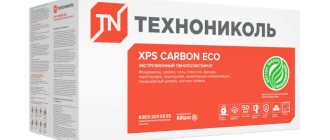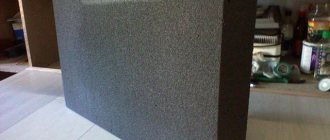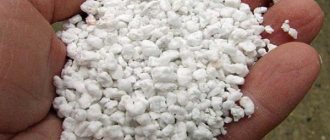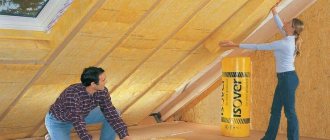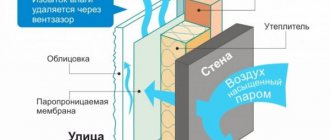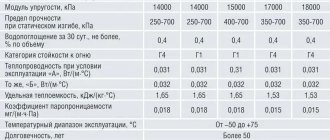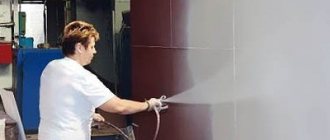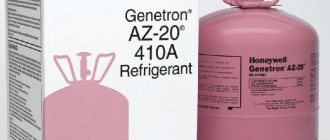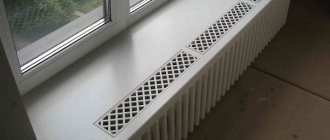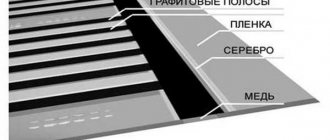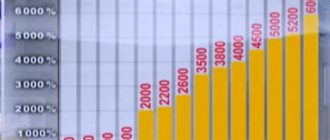A building can lose up to 1/5 of its heat through the roof, which means this is the Achilles heel in the thermal insulation of a room. And if a pitched roof is designed to retain cold due to a large air gap (attic), a flat roof does not have this opportunity. To solve problems, mainly insulation of flat roofs, the TechnoNikol insulation of the Tekhnoruf series was developed.
A quote taken from the manufacturer’s official website clearly indicates the scope of application of the material:
Purpose of Technoruf
Although, it is worth noting that pitched roofs can also be insulated with this material.
General Features
Tekhnoruf is mineral wool insulation in the form of rigid slabs. Hard because the minimum density is 121 kg per cubic meter. Considering the density, the conclusion immediately arises that the material is intended for highly loaded surfaces requiring insulation. For example, such an area is a used flat roof. The insulation can be attached to a metal or reinforced concrete base, and a concrete screed before or after the material is not a prerequisite. The table below provides the summary technical characteristics of Technoruf. If you are already a professional and are looking only for numbers, we will not detain you with unnecessary explanations.
| Outdated name | Density | Thickness, mm | Thermal conductivity A25 | Vapor permeability, not less than mg/(m h Pa) | Content of organic substances, no more, % | Compressive strength at 10% deformation, not less | |
| Tekhnoruf 45 | 126-154 | 50-150 | 0.038 | 0.3 | 4.5 | 45 | |
| Technoruf Technoruf PROF | 145-175 | 20-100 | 0.038 | 0.3 | 4.5 | 60 | |
| PROF with | 145-175 | 30-250 | 0.038 | 0.3 | 4.5 | 60 | |
| Technoruf N30 | 100-130 | 50-200 | 0.038 | 0.3 | 4.5 | 30 | |
| N OPTIMA | H35 | 100-120 | 50-250 | 0.038 | 0.3 | 4.5 | 35 |
| N EXTRA | 90-110 | 50-25 | 0.037 | 0.3 | 4.5 | 30 | |
| Technoruf V60 | 165-195 | 40-50 | 0.038 | 0.3 | 4.5 | 60 | |
| IN OPTIMA | 165-195 | 20-100 | 0.041 | 0.3 | 4.5 | 70 | |
| IN PROF | B80 | 175-205 | 20-100 | 0.041 | 0.3 | 4.5 | 80 |
| IN EXTRA | B70 | 155-185 | 40-50 | 0.038 | 0.3 | 4.5 | 65 |
| IN EXTRA with | 155-185 | 20-100 | 0.04 | 0.3 | 4.5 | 65 |
Features of the material and its properties
Tekhnoruf mineral insulation has proven itself well and is popular in the construction industry. Thermal insulation boards are made based on basalt fibers, which are arranged in horizontal and vertical directions, forming a multilayer structure. Organic matter is used as a binder. The technological process involves impregnation of the material with a water-repellent composition, giving the slabs high hydrophobic qualities. As a result, the products are characterized by:
- good indicator of heat and sound insulation;
- low water absorption value;
- non-flammability (class NG);
- stability when exposed to mechanical loads;
- stability of size, volume, shape.
Tekhnoruf slabs are used to construct an insulating layer during construction work and reconstruction of industrial and residential facilities. Due to its excellent strength characteristics and density, the insulation is suitable as the main insulating layer for roofing of any structure.
Mineral slabs are laid on reinforced concrete floors and metal bases made of profiled sheets. Along with thermal insulation properties, the material is resistant to fire, increasing the fire safety of the building.
Scary numbers in titles
As is customary in any company, indices in model names are for informational purposes. In the case of our material, numbers from 30 to 60 indicate the ability of the material to resist load. This value is indicated in Kilopascals. Previously, numbers up to 80 were used, however, recently these indices began to convey information not entirely accurately. For example, what was called Technoruf B70 in the past is now called V PROF and has a density index of 65, and the B50 index is not used at all. The type of marking Technoruf 50 also does not exist at the moment. If the manufacturer had left the previous index, it would not correspond to reality. It is also worth noting that the Technoruf N PROF index does not exist. There is only Tekhnoruf PROF (without the letter N) and it does not need a second, additional bottom layer.
The Great Mystery of All Time: B or H
As in the case of numbers, letters indicate the parameters of the ruler. Some representatives of the line can only be used in two-layer insulation systems. In this case, one is laid as the bottom layer and is designated by the letter “H”, and the second, respectively, as the top “B” (yes, not “second”, but “top”). Materials that do not have the index “H” or “B” are intended for single-layer insulation, for example, Tekhnoruf 45 or PROF insulation. Now try to say to yourself, say, what is hidden behind the H30 index. For those who missed the previous paragraph, names like “Extra” and “Optima” began to be used instead of digital indexes.
What is hidden behind the H30 index?
Laying features
Before you begin installing the slabs, you need to study their markings. In this case, H30 means that you are dealing with a basalt slab intended for laying the bottom layer of thermal insulation and capable of withstanding a load not exceeding 30 kPa/m2. If mechanical loads are not provided during the operation of the roof, material with the “N”
can be used without additional protection.
This is done differently when using the roof as a supporting surface. To cover the top layer of the roofing pie, distribute the load evenly and protect the bottom layer from mechanical damage, Tekhnoruf basalt slabs marked “B” are used,
capable of withstanding loads from 45 to 70 kPa/m2. Laying is carried out in several stages:
- The insulated surface is waterproofed using polyethylene film or roofing felt.
- Using special dowels with a wide washer, Tekhnoruf N30 insulation is installed. During the fastening process, the formation of cracks and gaps between the plates should be avoided, and the plates themselves should be staggered.
- The denser top layer is laid directly on the bottom layer, preventing the joints from matching.
- The top layer is covered with a PVC film membrane.
And one more thing for a snack
For complete clarity in the names, we only have to learn three names:
WEDGE
These are beveled slabs that are designed to create a roof slope;
Technoruf KLIN
FILLET
Insulation elements for the transition from a horizontal insulation surface to a vertical one. For example, for thermal insulation of a parapet.
Technoruf GALTEL
N VENT
This type of slab has special channels for draining water. This technology is intended to treat the disease of flat roofs - the formation of fungus and disturbances in the microclimate of the room.
Technoruf N VENT
Question about layers
Why might there be a need for two-layer insulation? It is no secret that Tekhnoruf slabs, like any mineral wool slabs, retain heat mainly due to air. It is gas that is a much smaller conductor of heat than solid matter. The more air in the slab, the lower the thermal conductivity, BUT, the lower the rigidity. Look again at the table just above. Find in it, for example, Technoruf V EXTRA (Technoruf B70). Its density ranges from 155 to 185 kg per cubic meter and the thermal conductivity coefficient is 0.038. Compare this indicator with Technoruf N EXTRA. 90-100 kg per m3 and 0.037. The difference in numbers is small, but it is there. And on large areas, a loss of one thousandth in the thermal conductivity coefficient results in hundreds of thousands of rubles in heating costs.
What do they use?
The most popular insulation in construction are Technoruf H30 and B60 . Their use is optimal in the middle regions of Russia. H30 is used for the bottom layer, and Tekhnoruf 60 insulation is used to cover the top layer, which is subject to high loads. Tekhnoruf 45, whose density is 126-154 kg per m3, is also in demand as a single-layer insulation.
We hope that this short description of the TechnoNikol roofing line will help you in insulating a flat roof or other roof. Or maybe, like some enthusiasts, you decide to use the material even to insulate the facade. In any case, do not forget to look at the instructions from the manufacturer, drink more hot tea in winter and look at the stars more often.
Installation Features
Let’s immediately say that installing the heat insulator described in the article is a fairly simple procedure. First, the working surface is thoroughly cleaned of all foreign objects present on it. After this, a vapor barrier layer is laid over the entire area (both a polymer membrane and bituminous materials can be used as such). The joints between the strips of insulating material are glued using mounting tape.
Note! The insulation boards themselves should be laid in a checkerboard pattern (that is, so that the joints of adjacent rows do not coincide). To fasten the material, special telescopic dowels must be used (approximately two to three units for each of the insulator plates)
For a more detailed understanding of the installation process, we recommend that you read the step-by-step instructions below. As you can see, it is quite short, which is another proof of the ease and simplicity of the process. The algorithm of actions should be as follows.
Step one. The working surface is thoroughly cleaned of all foreign objects on it, as well as dirt and debris.
Step two. A vapor barrier material is laid around the entire perimeter (as such, as noted above, both polymer membranes and bitumen-based insulators can be used). The joints between the strips are glued using mounting tape, and the strips themselves are laid with an overlap. It is also worth noting that the vapor barrier should be installed on the sides of the roof to the height of the entire thickness of the insulating pie plus 20 millimeters.
Step three. Plates of insulating material (modification H, although in most cases H30 is used, as far as we already know) are laid on top of the vapor barrier. Laying is done in a checkerboard pattern - the same way, for example, bricks are laid (the joints of adjacent rows should not coincide). To fasten the insulation, special telescopic dowels are used (two units for each of the plates, although you can increase the strength and use three or even four).
Step four. Modification B slabs are installed on top of the lower insulating layer (they are intended for the top layer of the cake); in this case, telescopic dowels made of nylon are used for fixation. The joints in this case are also tied (in other words, the joints of the lower row should be located approximately in the center of the slabs of the upper row - they seem to overlap). The specific type of dowel anchor elements should be selected according to the floor material in each particular case.
Step five. A waterproofing material is laid on top of the insulation (the best option is a polyvinyl chloride membrane).
Note! Places of contact with sides or pipes, as well as various slopes, are organized using special additional/shaped components, which were also provided by the manufacturer. These components are also made of basalt wool, so they can be used for arranging roofs of various shapes
As you can see, no specific skills or knowledge are required here. The only thing that may be difficult is the installation of a PVC membrane, since this will require experience in working with similar materials, as well as welding work.
Video - Installation of Tehnoruf insulation
